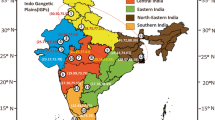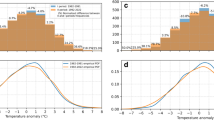Abstract
Satellite measurements provided by NASA (USA) at http://ozonewatch.gsfc.nasa.gov are used to study the variability and interdependence of polar ozone, polar temperature, and mean zonal wind. A model of winter/spring polar ozone in the Arctic and Antarctic is constructed using data on polar temperatures at 30, 70, and 100 hPa levels and mean zonal wind at 10 and 70 hPa levels in the latitude zone of 45°–75°. The results of the statistical analysis of the 1979–2020 polar ozone calculation errors are presented.


Similar content being viewed by others
REFERENCES
Yu. E. Belikov and Sh. S. Nikolaishvili, “Ozone Holes as a Result of Ozone Destruction on Charged Particles,” Geliogeofizicheskie Issledovaniya, No. 16 (2017) [in Russian].
A. N. Gruzdev, “Estimate of the Effects of Pinatubo Eruption in Stratospheric O3 and NO2 Contents Taking into Account the Variations in the Solar Activity,” Optika Atmosfery i Okeana, No. 6, 27 (2014) [Atmos. Ocean. Opt., 27 (2014)].
A. M. Zvyagintsev and G. M. Kruchenitskii, “Estimates of the Trend in Total Ozone Content over Europe and Variations in the Global Atmospheric Circulation,” Optika Atmosfery i Okeana, No. 9, 10 (1997) [in Russian].
N. S. Ivanova, G. M. Kruchenitskii, I. N. Kuznetsova, V. I. Demin, and V. A. Lapchenko, “Ozone Content over the Russian Federation in the First Quarter of 2020,” Meteorol. Gidrol., No. 6 (2020) [Russ. Meteorol. Hydrol., No. 6, 45 (2020)].
N. S. Ivanova, G. M. Kruchenitskii, I. N. Kuznetsova, and E. A. Lezina, “Ozone Content over the Russian Federation in the Second Quarter of 2020,” Meteorol. Gidrol., No. 8 (2020) [Russ. Meteorol. Hydrol., No. 8, 45 (2020)].
K. Mohanakumar, Stratosphere Troposphere Interactions (FIZMATLIT, Moscow, 2011) [Transl. from English].
S. P. Smyshlyaev, A. I. Pogoreltsev, V. Ya. Galin, and E. A. Drobashevskaya, “Influence of Wave Activity on the Composition of the Polar Stratosphere,” Geomagnetizm i Aeronomiya, No. 1, 56 (2016) [Geomagn. Aeron., No. 1, 56 (2016)].
G. P. Brasscur and C. Granier, “Mount Pinatubo Aerosols, Chlorofluorocarbons, and Ozone Depletion,” Science, 257 (1992).
D. J. Hofmann, T. L. Deshler, P. Aimedieu, W. A. Matthews, P. V. Johnston, Y. Kondo, W. R. Sheldon, G. J. Byrne, and J. R. Benbrook, “Stratospheric Clouds and Ozone Depletion in the Arctic during January 1989,” Nature, No. 6229, 340 (1989).
R. Hossaini, M. P. Chipperfield, S. A. Montzka, A. Rap, S. Dhomse, and W. Feng, “Efficiency of Short-lived Halogens at Influencing Climate through Depletion of Stratospheric Ozone,” Nature Geosci., No. 3, 8 (2015).
P. E. Huck, A. J. McDonald, G. E. Bodeker, and H. Struthers, “Interannual Variability in Antarctic Ozone Depletion Controlled by Planetary Waves and Polar Temperature,” Geophys. Res. Lett., 32 (2005).
A. A. Krivolutsky, A. A. Kuminov, T. Yu. V’yushkova, S. N. Kuznetsov, and I. N. Myagkova, “Changes in the Earth’s Ozonosphere due to Ionization of High-latitude Atmosphere by Solar Protons in October, 2003,” Cosmic Res., No. 6, 42 (2004).
R. W. Portmann, S. Solomon, R. R. Garcia, L. W. Thomason, L. R. Poole, and M. P. McCormick, “Role of Aerosol Variations in Anthropogenic Ozone Depletion in the Polar Regions,” J. Geophys. Res., 101 (1996).
T. G. Shepherd, D. A. Plummer, J. F. Scinocca, M. I. Hegglin, V. E. Fioletov, M. C. Reader, E. Remsberg, T. von Clarmann, and H. J. Wang, “Reconciliation of Halogen-induced Ozone Loss with the Total-column Ozone Record,” Nature Geosci., 7 (2014).
S. Solomon, J. Haskins, D. J. Ivy, and F. Min, “Fundamental Differences between Arctic and Antarctic Ozone Depletion,” in Proceedings of the National Academy of Sciences USA (PNAS), No. 17, 111 (2014).
S. E. Strahan, A. R. Douglass, and P. A. Newman, “The Contributions of Chemistry and Transport to Low Arctic Ozone in March 2011 Derived from Aura MLS Observations,” J. Geophys. Res. Atmos., 118 (2013).
T. Wegner, J.-U. Grooss, M. von Hobe, F. Stroh, O. Suminska-Ebersoldt, C. M. Volk, E. Hosen, V. Mitev, G. Shur, and R. Muller, “Heterogeneous Chlorine Activation on Stratospheric Aerosols and Clouds in Arctic Polar Vortex,” Atmos. Chem. Phys., No. 22, 12 (2012).
V. V. Zuev, N. E. Zueva, and E. S. Savelieva, “The Antarctic Ozone Depletion Caused by Erebus Volcano Gas Emissions,” Atmos. Environ., 122 (2015).
Author information
Authors and Affiliations
Corresponding author
Additional information
Translated from Meteorologiya i Gidrologiya, 2021, No. 5, pp. 16-24. https://doi.org/10.52002/0130-2906-2021-5-16-24.
About this article
Cite this article
Ivanova, N.S. A Statistical Model of Winter/Spring Polar Ozone. Russ. Meteorol. Hydrol. 46, 295–301 (2021). https://doi.org/10.3103/S1068373921050022
Received:
Published:
Issue Date:
DOI: https://doi.org/10.3103/S1068373921050022




